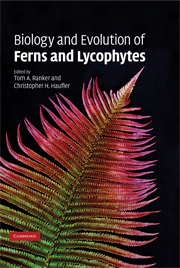Book contents
- Frontmatter
- Contents
- List of contributors
- Preface
- Acknowledgments
- Part I Development and morphogenesis
- 1 Photoresponses in fern gametophytes
- 2 Alternation of generations
- 3 Meristem organization and organ diversity
- Part II Genetics and reproduction
- Part III Ecology
- Part IV Systematics and evolutionary biology
- Index
- References
3 - Meristem organization and organ diversity
Published online by Cambridge University Press: 11 August 2009
- Frontmatter
- Contents
- List of contributors
- Preface
- Acknowledgments
- Part I Development and morphogenesis
- 1 Photoresponses in fern gametophytes
- 2 Alternation of generations
- 3 Meristem organization and organ diversity
- Part II Genetics and reproduction
- Part III Ecology
- Part IV Systematics and evolutionary biology
- Index
- References
Summary
Introduction
Vascular plants are classified into two groups, microphyllous lycophytes and megaphyllous euphyllophytes (ferns including whisk ferns and horsetails, and seed plants). This classification is based on comparative morphology (Kenrick and Crane, 1997), and it is consistent with recent molecular phylogenetic analyses (Qiu and Palmer, 1999; Pryer et al., 2001; 2004, Qiu et al., 2006; see Chapter 15). Based on this classification, it seems likely that the stem, the leaf, and the root evolved independently in both plant groups. In addition, the root-producing organs called the rhizophore and rhizomorph have evolved only in lycophytes (Kato and Imaichi, 1997). The evolutionary origins of these organs have been proposed mainly based on comparative morphology and anatomy of extant as well as fossil plants (Gifford and Foster, 1989; Stewart and Rothwell, 1993).
Each organ develops through a series of individual morphogenetic events (ontogeny), so attention should be and has been focused on the role of developmental changes during evolutionary diversification. If the ontogeny of a given organ is modified by addition or deletion of specific morphogenetic events to or from the original morphogenetic series, or is modified by alteration of the timing of morphogenetic events, such as retardation or acceleration (heterochrony), the final organ shape could change, leading to evolution of specialized and novel organs (e.g., Gould, 1977; Kluge, 1988; Imaichi and Kato, 1992). Therefore, comparison of morphogenetic events (development) among organs in the context of phylogeny should offer clues for improving the evolutionary scenarios of certain organs.
- Type
- Chapter
- Information
- Biology and Evolution of Ferns and Lycophytes , pp. 75 - 104Publisher: Cambridge University PressPrint publication year: 2008
References
- 21
- Cited by



